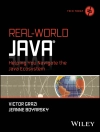Learn the principles behind object-oriented programming and within a few chapters create a fully functional Ruby application. You’ll also gain a basic understanding of many ancillary technologies such as databases, XML, web frameworks, and networking — some of which are needed as part of a fully functioning Ruby application.
Based on the bestselling first and second editions, Beginning Ruby, Third Edition is a leading guide to learn Ruby from the ground up. The new edition of this book provides the same excellent introduction to Ruby as the previous editions plus updates for the newest version of Ruby 2.3. This book can also be used as a textbook or companion to a textbook on beginning Ruby programming.
The light and agile Ruby programming language remains a very popular open source scripting option for developers building today’s web and even some enterprise applications. And, now, Ruby also has applications using the Raspberry Pi, popular among hobbyists and makers. Many former Java developers still use Ruby on Rails today, the most popular framework for building Ruby applications.
What You’ll Learn
- Discover the fundamentals of Ruby and its object-oriented building blocks
- Use the Ruby libraries, gems, and documentation
- Work with files and databases
- Write and deploy Ruby applications
- Harness the various Ruby web frameworks and how to use them
- Do network programming with Ruby
Who This Book Is For
Beginning programmers, programmers new to Ruby, and web developers interested in learning and knowing the foundations of the Ruby programming language.
Содержание
1. Let’s Get It Started: Installing Ruby.- 2. Programming = Joy: A Whistle-Stop Tour of Ruby and Object Orientation.- 3. Ruby’s Building Blocks: Data, Expressions, and Flow Control.- 4. Developing Your First Ruby Application.- 5. The Ruby Ecosystem.- 6. Classes, Objects, and Modules.- 7. Projects and Libraries.- 8. Documentation, Error Handling, Debugging, and Testing.- 9. Files and Databases.- 10. Deploying Ruby Applications and Libraries.- 11. Advanced Ruby Features.- 12. Tying It Together: Developing a Larger Ruby Application.- 13. Web Application Frameworks: Rails, Sinatra, and Ramaze.- 14. Ruby and the Internet.- 15. Networking, Sockets, and Daemons.- 16. Useful Ruby Libraries.- Appendix A. Ruby Primer and Review for Developers.- Appendix B. Useful Resources.
Об авторе
Peter Cooper is an experienced Ruby developer, trainer, and publisher who runs Ruby Inside, the most popular blog in the Ruby and Rails worlds, with 18, 000 subscribers. He also curates Ruby Flow, a popular Ruby community link blog. Over the past few years he has developed, launched, and sold two startups (Feed Digest and Code Snippets), both powered by Ruby and Rails.












